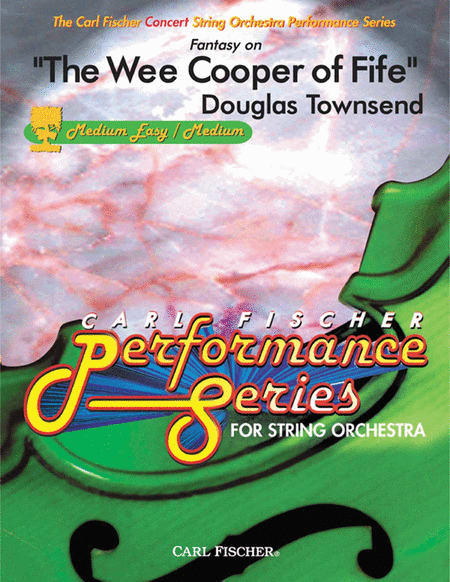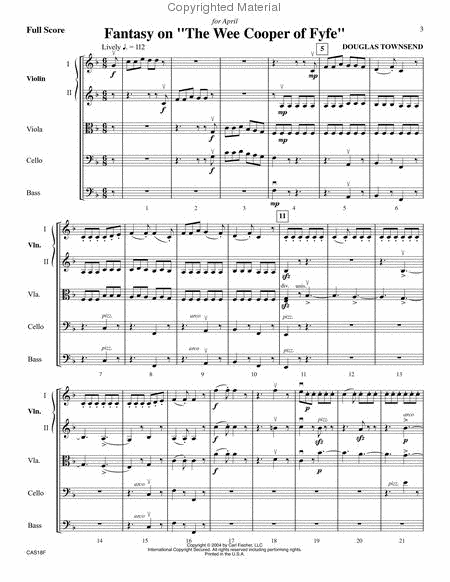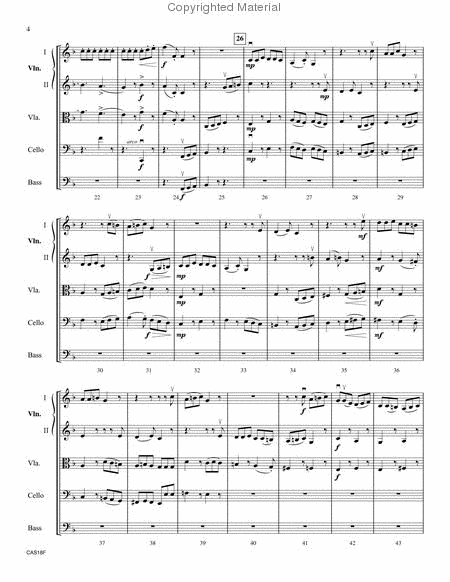Fantasy on 'The Wee Cooper of Fife'
-
Ships in 1 to 2 weeks
Details
Description
SKU: CF.CAS18
Composed by Douglas Townsend. Carl Fischer Concert String Orchestra Series. Score and Parts. With Standard notation. 12 pages. Carl Fischer Music #CAS18. Published by Carl Fischer Music (CF.CAS18).ISBN 9780825855016. UPC: 798408055011. 8.5 X 11 inches. Key: F major.
A truly masterful fantasy on an English folk song, this piece shows the exceptional musical development found in many of the greatest classical symphonies. The fantasy is roughly in the style of the classical rondo (ABACA) and features fine counterpoint and engaging melodies. This piece can be played in an orchestral and quartet setting and is both challenging and fun to play.
My Fantasy on The Wee Cooper of Fife was one of four such fantasies I wrote for my daughter April when she was studying the violin, and I had hopes that when she reached the age of wisdom and proficiency she would play them with her friends. Life being what is it, she eventually gave up the violin and chose a completely different career for herself-though we are still the best of friends! I found the song in a collection of folk songs for children where it is called Rissoldy Rossoldy. Except for a few notes, the song was almost identical to the English folksong The Wee Cooper of Fife, which begins: There was a Wee Cooper named Fife / nickity nackety roo noo roo / He took him to wed a gentle wife / nickity nackety roo noo roo / She would na card she would na spin / for fear 't would harm her gentle skin.... The tune is rollicking and words are amusing, and yes, eventually they worked out their problems! The Fantasy is roughly in the style of the classical rondo, which is ABACA coda, such as one finds in the last movements of some of Haydn's later symphonies. This composition may be performed by a string orchestra or solo string quartet. - Douglas Townsend.
MyA Fantasy on The Wee Cooper of FifeA was one of four such fantasies I wrote for my daughter April when she was studying the violin, and I had hopes that when she reached the age of wisdom and proficiency she would play them with her friends. Life being what is it, she eventually gave up the violin and chose a completely different career for herself-though we are still the best of friends! I found the song in a collection of folk songs for children where it is calledA Rissoldy Rossoldy.A Except for a few notes, the song was almost identical to the English folksongA The Wee Cooper of Fife, which begins: There was a Wee Cooper named Fife / nickity nackety roo noo roo / He took him to wed a gentle wife / nickity nackety roo noo roo / She would na card she would na spin / for fear 't would harm her gentle skin.... The tune is rollicking and words are amusing, and yes, eventually they worked out their problems! The Fantasy is roughly in the style of the classical rondo, which is ABACA coda, such as one finds in the last movements of some of Haydn's later symphonies. This composition may be performed by a string orchestra or solo string quartet. - Douglas Townsend.
MyA Fantasy on "The Wee Cooper of Fife"A was one of four such fantasies I wrote for my daughter April when she was studying the violin, and I had hopes that when she reached the age of wisdom and proficiency she would play them with her friends. Life being what is it, she eventually gave up the violin and chose a completely different career for herself-though we are still the best of friends! I found the song in a collection of folk songs for children where it is calledA Rissoldy Rossoldy.A Except for a few notes, the song was almost identical to the English folksongA The Wee Cooper of Fife, which begins: "There was a Wee Cooper named Fife / nickity nackety roo noo roo / He took him to wed a gentle wife / nickity nackety roo noo roo / She would na card she would na spin / for fear 't would harm her gentle skin...." The tune is rollicking and words are amusing, and yes, eventually they worked out their problems! The Fantasy is roughly in the style of the classical rondo, which is ABACA coda, such as one finds in the last movements of some of Haydn's later symphonies. This composition may be performed by a string orchestra or solo string quartet. - Douglas Townsend.
My Fantasy on "The Wee Cooper of Fife" was one of four such fantasies I wrote for my daughter April when she was studying the violin, and I had hopes that when she reached the age of wisdom and proficiency she would play them with her friends. Life being what is it, she eventually gave up the violin and chose a completely different career for herself-though we are still the best of friends! I found the song in a collection of folk songs for children where it is called Rissoldy Rossoldy. Except for a few notes, the song was almost identical to the English folksong The Wee Cooper of Fife, which begins: "There was a Wee Cooper named Fife / nickity nackety roo noo roo / He took him to wed a gentle wife / nickity nackety roo noo roo / She would na card she would na spin / for fear 't would harm her gentle skin...." The tune is rollicking and words are amusing, and yes, eventually they worked out their problems! The Fantasy is roughly in the style of the classical rondo, which is ABACA coda, such as one finds in the last movements of some of Haydn's later symphonies. This composition may be performed by a string orchestra or solo string quartet. - Douglas Townsend.
My Fantasy on "The Wee Cooper of Fife" was one of four such fantasies I wrote for my daughter April when she was studying the violin, and I had hopes that when she reached the age of wisdom and proficiency she would play them with her friends. Life being what is it, she eventually gave up the violin and chose a completely different career for herself-though we are still the best of friends! I found the song in a collection of folk songs for children where it is called Rissoldy Rossoldy. Except for a few notes, the song was almost identical to the English folksong The Wee Cooper of Fife, which begins: "There was a Wee Cooper named Fife / nickity nackety roo noo roo / He took him to wed a gentle wife / nickity nackety roo noo roo / She would na card she would na spin / for fear 't would harm her gentle skin...." The tune is rollicking and words are amusing, and yes, eventually they worked out their problems! The Fantasy is roughly in the style of the classical rondo, which is ABACA coda, such as one finds in the last movements of some of Haydn's later symphonies. This composition may be performed by a string orchestra or solo string quartet. - Douglas Townsend.
My Fantasy on "The Wee Cooper of Fife" was one of four such fantasies I wrote for my daughter April when she was studying the violin, and I had hopes that when she reached the age of wisdom and proficiency she would play them with her friends. Life being what is it, she eventually gave up the violin and chose a completely different career for herself-though we are still the best of friends!I found the song in a collection of folk songs for children where it is called Rissoldy Rossoldy. Except for a few notes, the song was almost identical to the English folksong The Wee Cooper of Fife, which begins:"There was a Wee Cooper named Fife / nickity nackety roo noo roo / He took him to wed a gentle wife / nickity nackety roo noo roo / She would na card she would na spin / for fear 't would harm her gentle skin...."The tune is rollicking and words are amusing, and yes, eventually they worked out their problems!The Fantasy is roughly in the style of the classical rondo, which is ABACA coda, such as one finds in the last movements of some of Haydn's later symphonies.This composition may be performed by a string orchestra or solo string quartet.- Douglas Townsend.
About Carl Fischer Concert String Orchestra Series
This series of pieces (Grade 3 and higher) is designed for advancing ensembles. The pieces in this series are characterized by:
- Expanded use of rhythms, ranges and keys but technical demands are still carefully considered
- More comprehensive bowing techniques
- Viola T.C. included
- Careful selection of keys and degree of difficulty for advancing musicians



 Share
Share